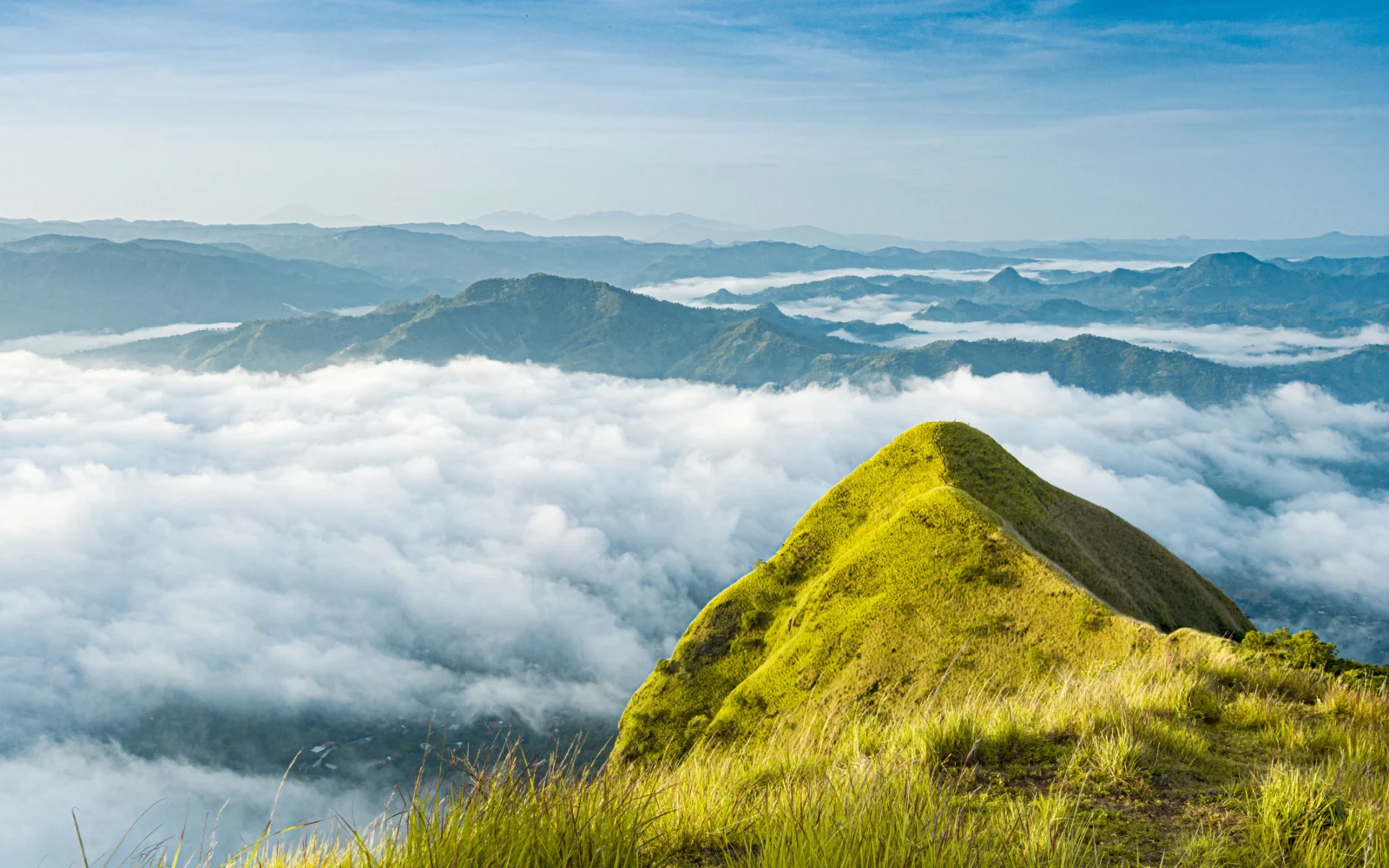If you’re an avid world traveler looking for your next inspiring vacation destination off the beaten path, why not plan your next adventure in El Salvador? It’s not visited as often as neighboring Belize or Guatemala, making it a hidden gem destination with much to see and explore.
This tropical paradise boasts Mayan ruins, sleepy beach towns, volcanic landscapes, and vast parks teeming with wildlife and plants. From rugged hiking trails to pristine beaches, you’ll find a multitude of experiences that make it well worth the visit. We’ll show you why below.
The 15 Best Places to Visit in El Salvador
El Salvador (“the Savior”) is rich in adventure, with sandy beaches and surfing swells in coastal La Libertad, ancient Mayan ruins near Chalchuapa, volcanoes by the hundreds, and cacao and coffee plantations nestled in the fertile hills and highlands.
The best places to visit in El Salvador will take you through these varied landscapes and into historic cities and villages for a close-up look at what makes this Central American country so fascinating.
From architecture and markets in the capital to cultural expression in small towns and natural beauty in between, El Salvador has become a favorite destination for world travelers.
You’ll make the most of your visit with a list of the best places to visit in El Salvador, laid out for you below with travel tips, adventurous things to do, and sightseeing opportunities you won’t want to miss!
1. San Salvador
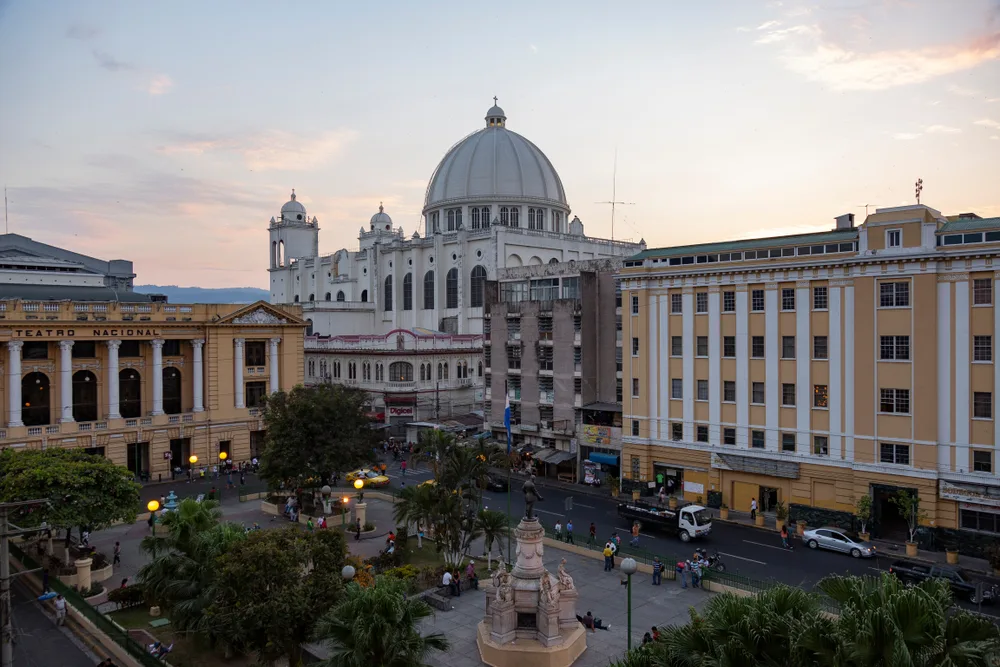
San Salvador, El Salvador, Central America, Februar 06, 2014: El Centro historico de San Salvador, San Salvador Cathedral and national Theater, Street Scene/Ohne Titel/Shutterstock
What’s better for your first foray into El Salvador than visiting its capital, San Salvador? This bustling city near the southern coast is the country’s cultural hub, packed with historic architecture, excellent food and nightlife, and colorful markets — all with incredible views of the San Salvador volcano.
Check out the National Palace to learn about the country’s history, the 1970’s-designed Iglesia El Rosario, where the altar reflects a rainbow prism of light from glass arranged in an arched roof, and the Art Museum of El Salvador, which houses paintings and sculptural works by local artists.
Nearby, El Boqueron National Park sits atop the San Salvador volcano with a huge crater (nearly 600 feet deep) hikers can explore with a cinder cone at its center. Restaurants, a Boqueron crater slide, and shaded hiking trails make it one of our favorite spots to visit in San Salvador.
San Salvador’s markets are one of the best ways to really get to know the city, so pick up some souvenirs and handcrafted goods while you’re here! The National Craft Market and Central Market are both excellent for first-time visitors.
Don’t forget to grab a cup of El Salvadoran coffee grown right in the nearby highlands, stop at a bar (like La Dalia, the oldest in the country) for drinks, and explore the flavorful cuisine at locally-owned restaurants and street carts in the heart of the city.
Sitting under an hour away from the coast, San Salvador makes a great stop on your way to check out El Salvador’s best beaches for surfing or interesting port cities along the coast.
2. Santa Ana
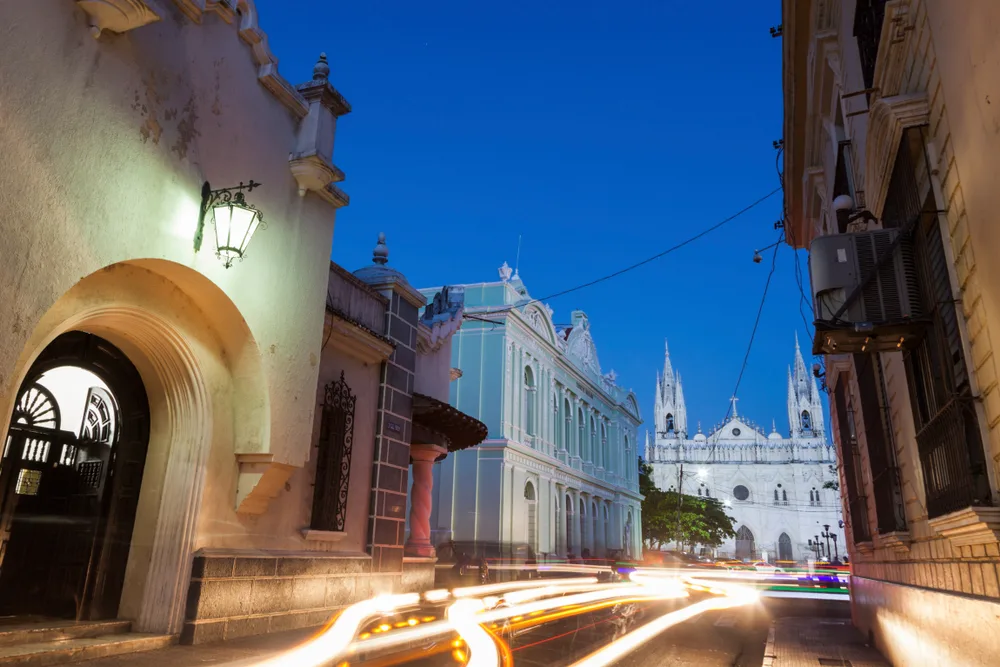
Henryk Sadura/Shutterstock
Known as the Heroic City, Santa Ana sits in the coffee region of El Salvador, nestled in a basin between mountains with gorgeous peak views surrounding the city. Gothic architecture and manicured parks make it feel like a taste of Europe here in Central America.
In the western region of El Salvador, Santa Ana is cosmopolitan in some ways and deeply El Salvadoran in others. The Neo-Gothic Santa Ana Cathedral is the main landmark in the city with twin spires that give it an imposing, hauntingly beautiful appearance.
The cathedral is in the main square, Parque Libertad, along with other stunning architectural examples like the Santa Ana National Theater (you can see shows like symphonies, plays, and operas here) and the Neoclassical city hall. It’s the perfect spot to walk around and sightsee for a couple of hours.
A mile from the main square, check out Mercado Central de Santa Ana for handcrafted goods made and sold by locals in a bustling setting filled with aromas from freshly made foods and baked goods.
Looking to explore even more? Take a tour of the La Ruta de Las Flores (the Flowers Route) to nearby towns, like Apaneca and Ataco, near Santa Ana for awesome regional food and craft markets.
Just 50 minutes away, you can visit Los Volcanes National Park to see the Santa Ana Volcano and 2 smaller volcanoes. Hike up to the crater (1.5 hour moderate to hard hike) for stunning, panoramic views of the forests, mountains, and cities nearby. Visit the crater lake, Lago de Coatepeque, nearby!
3. Suchitoto
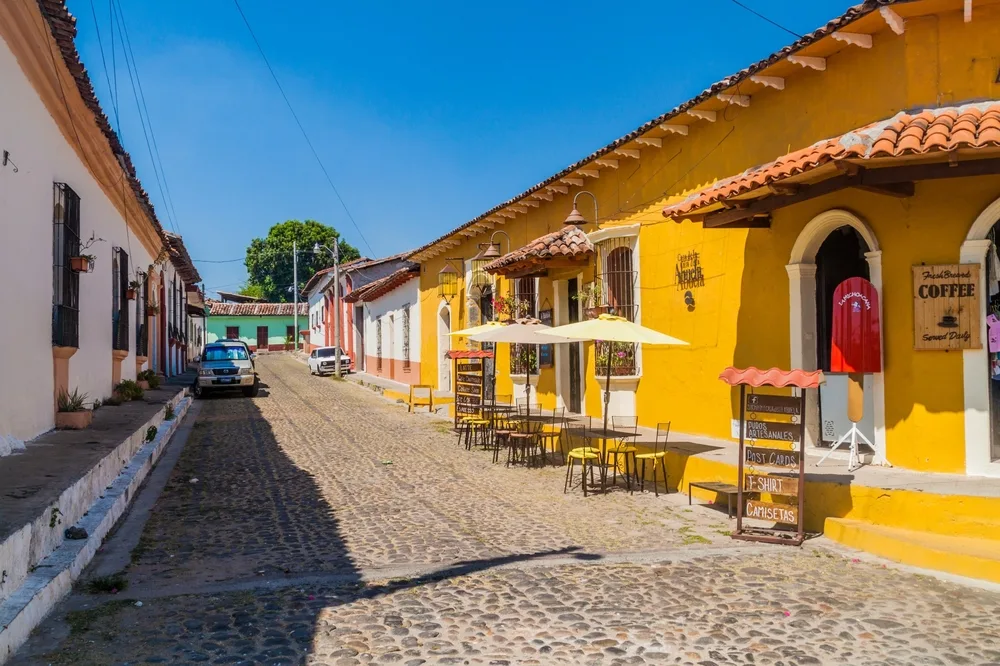
SUCHITOTO, EL SALVADOR – APRIL 9, 2016: Cobbled street in Suchitoto, El Salvador/Matyas Rehak/Shutterstock
A remarkably preserved Colonial town in the mountains, Suchitoto is one of the most-visited small towns in El Salvador with its historic architecture, cobblestone streets, and scenic setting among the El Salvadoran highlands.
You’ll wander the cobbled streets with Colonial-era architecture on either side in the center of town, bringing you into a lost chapter of time and giving you the feeling that you’re far away from the outside, modern world.
Take a half-day tour of Old Town Suchitoto in Parque Central, the main square, to see the sights: the 19th-century Santa Lucia Church, and the Theater of Alejandro Cotto with gardens, courtyards, antiques, and memorabilia from Latin film stars.
The town’s mountain location also brings sweeping, beautiful views over the entire region. Suchitoto overlooks Lago de Suchitlán to the north, a gorgeous reservoir created by a dam. You’ll find cafes and eateries set up around this area where you can access some of the best lake views.
The Peace Arts Center in Suchitoto is where you’ll find a museum, an art gallery, and lush gardens blooming in front of the former convent-turned-art haven.
Check out the House of Crafts, where local vendors sell colorful hand-dyed textiles and artwork, and the curious A Thousand Plates And More Museum, where a local’s collection of unique plates offers an interesting spot to spend an hour wandering right in the town’s center.
The eating is good around Suchitoto, so be sure to try the traditional Gallo en chicha at Los Almendros De San Lorenzo and piled-high pupusas at Donde Charlie for authentic treats!
4. Juayua
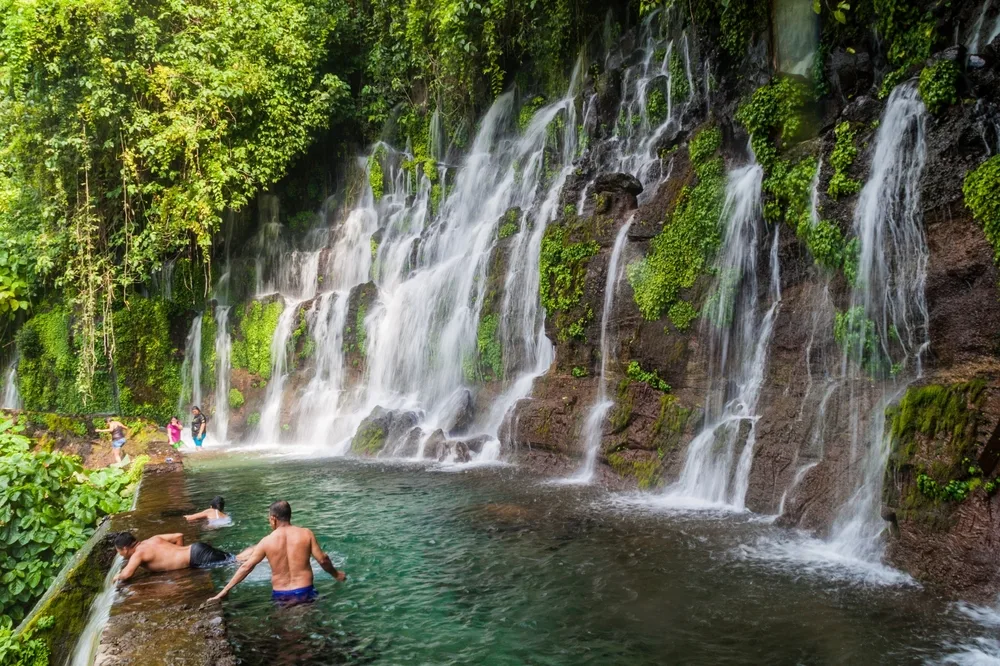
JUAYUA, EL SALVADOR – APRIL 3, 2016: People bathing in Chorros de la Calera, set of waterfalls near Juayua village, El Salvador/Matyas Rehak/Shutterstock
Nestled in the mountains near San Salvador, Juayua is on the La Ruta de Las Flores in one of the most scenic parts of El Salvador. Founded in the mid-15th century, this small town packs a lot of history and architecture into its idyllic mountainside setting.
Tourists flock to Juayua because it offers the perfect mix of authentic El Salvador and attractions that make it interesting to visit. Surrounded by natural beauty with Pre-Columbian roots, this town is firmly in coffee country and some of El Salvador’s best beans are grown in the mountains here.
Tidy little cafes and restaurants serve up traditional cuisine, as well as twists on American and European dishes, for you to fuel up for a day of adventures, tours, and sightseeing. In the center of town, Templo del Senor Juayua is famous for its black Christ statue and colorful red crucifix accents.
Head to one of the nearby coffee plantations, like Cafe Juayua, to get a behind-the-scenes look at how the beans are grown in the rich, volcanic soils, then roasted and brewed to perfection.
There are 4 waterfalls close by (Los Chorros de La Calera), with 3 others you can see if you decide to do the full Route of the Seven Waterfalls. Water thunders off the mountainsides from varying heights surrounded by dense forest and incredible hiking trails.
Weekends mean it’s time for the Juayua Food Festival in the Parque Central (town square), when dozens of vendors set up carts along the streets and sell traditional grilled meats, seafood, sweets, drinks, and snacks. It’s a must if you’re here on the weekend!
5. Gulf of Fonseca
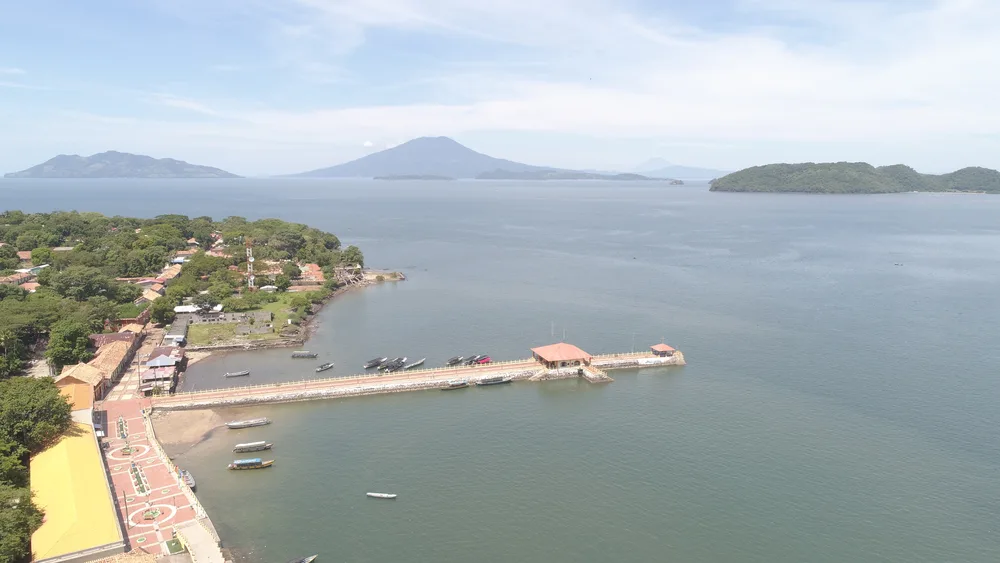
Ernesto Carcamo/Shutterstock
The Gulf of Fonseca touches El Salvador, Honduras, and Nicaragua, offering a serene little shelter from the wider Pacific Ocean. Volcanic islands rise from the gulf and you can take a boat cruise around or to the islands to extend your getaway off the mainland!
There are over a dozen small islands visible from the coastline, including Isla Zacatillo (excellent fishing with local guides), Meanguera (small-town vibes with a cute park and beaches), and Conchaguita (Conchaguita volcano, hiking trails, and beaches).
The history surrounding the Gulf of Fonseca is astounding, spanning back to pre-Hispanic periods with important sites like shell mounds, church ruins, and fishing communities that are still surviving today with the abundance of shellfish in the gulf.
Take a boat from Familia Park in La Unión, where operators wait near the food court with endless pupuserías to whisk you away to the islands and out on the waters of the warm gulf.
You’ll be able to swim, snorkel, surf, and try local food and drinks once you arrive at a tranquil private beach. The islands range from unspoiled natural beauty to more developed areas with restaurants, hotels, and small communities that thrive in the middle of the gulf.
Not up for a trip to the islands? Las Tunas (black sand beach), Playa El Chiquirin, Playa Largarto, and Playitas beaches are all on the El Salvadoran coast bordering the gulf, each one offering a different vibe and scenic views of the offshore islands with roomy stretches of coffee-colored sand.
6. Apaneca
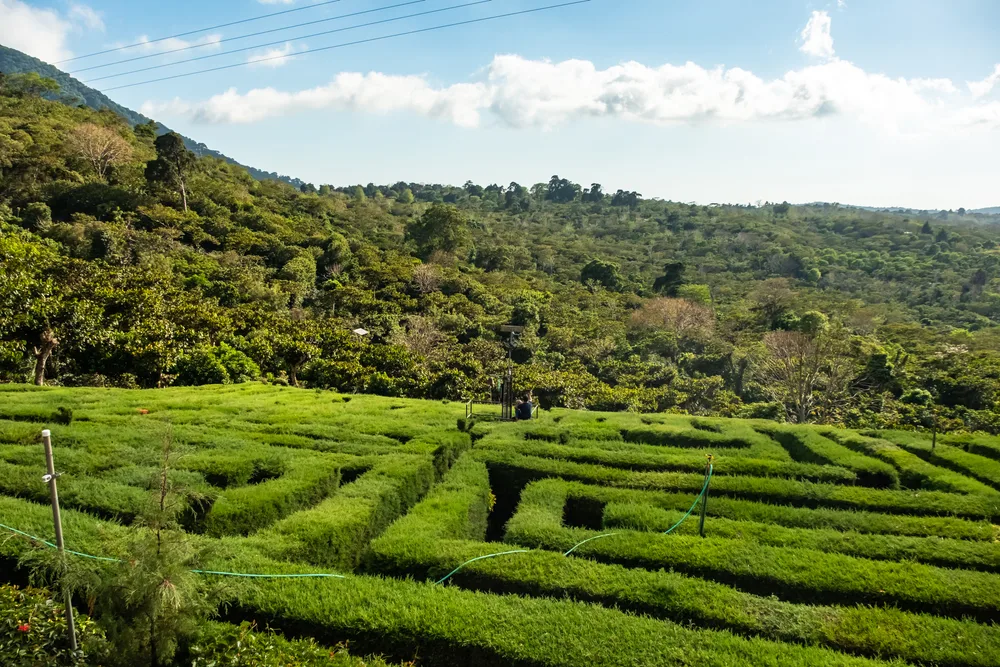
OutxThere/Shutterstock
Another town on the scenic La Ruta de Las Flores is Apaneca, a small village that’s ringed with green coffee plantations and mountain views. Coffee country is one of our favorite parts of El Salvador for its lush appearance and chances to immerse yourself in traditional culture.
Here in the western side of El Salvador, you’re high up in the mountains with so many options if you’d like to do some outdoor activities like hiking to waterfalls, visiting scenic overlooks, and touring the beautiful plantations, like Lachuza Cafe, that cling to the mountainsides in the balmy, cool air.
Within the town, the houses are small and brightly colored with the center of town featuring cobblestone streets laid long ago. There’s an old white-washed Colonial church you can stroll past and the Plaza Turistica is packed with local shops and spots to eat.
The gastronomy scene is surprisingly great here, with local restaurants serving specials like sopa de gallina india (free-range hen soup), sweet Salvadoran quesadillas (similar to pound cake), and pupusas. Visit El Jardín de Celeste for the house-made Xóchitl soup.
An interesting stop is the Albania Labyrinth, the largest maze in Central America with massive rows of cypress trees creating a dense maze that makes for a fun afternoon. Close to Juayua and the many waterfalls surrounding it, there are several miradors offering stunning views around Apaneca.
Check out Laguna Las Ninfas and Laguna Verde — two large lakes tucked into the mountains — and the hiking trails that lead around them. As far as accommodations, you’ll find small hotels, cabins, and hostels that offer great views of volcanoes and green-blanketed mountains.
7. El Imposible National Park
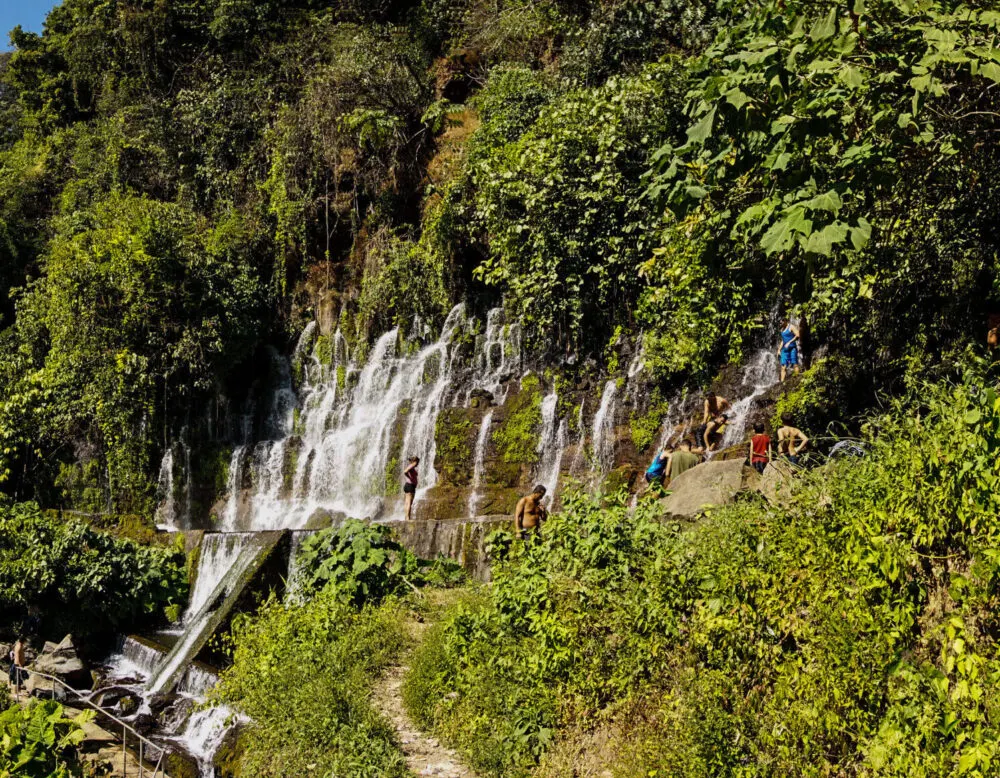
chriontour/Shutterstock
Nestled in the mountains of El Salvador, you’ll find the wildlife and forest oasis of El Imposible National Park. This area is so lush and scenic that hiking its many trails and swimming in its rivers it might be your favorite part of your trip to El Salvador.
Jump into the river from high cliffs, see cascading waterfalls, venture deep into canyons, and hike steep trails that lead to panoramic views of the surrounding mountains and volcanoes in this beautiful park.
You’ll want a guide — they’re easy to find in nearby towns like Tacuba (arrange through Mamas y Papas Hostel) with affordable rates and can show you the wonders of the park, from the most impressive to hidden gem sights.
An experienced guide will be able to lead you to wildlife in the park, like sloths, monkeys, macaws, and toucans — all surprisingly easy to miss if you don’t know where to look! The ecologically diverse park is home to hundreds of animal, insect, and plant species.
Arrange hiking, canyoning, swimming, river rafting, waterfall tours, and more with your guide. The rivers that run through the park supply its flora and fauna with life and make for awesome adventures on rafts and kayaks through the beautiful natural setting.
Nature aside, this park can offer points of interest for those who enjoy learning about historic civilizations and archaeology. Within the park, there are 8 pre-Hispanic sites with carvings, ruins, and more — check out Piedra Sellada to see ancient carvings up close.
8. El Tunco
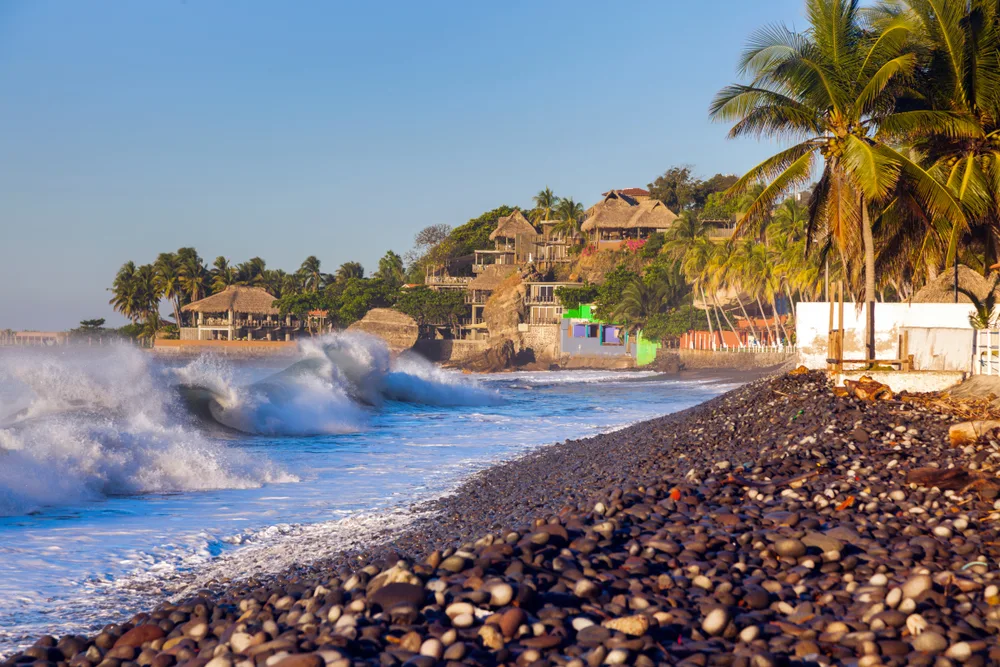
Henryk Sadura/Shutterstock
El Tunco and Playa El Tunco (the beach) are one of the more tourist-centric areas of El Salvador. If you’re looking for scenic sunsets, beachfront restaurants and clubs, and a small beach town with welcoming vibes that’s popular with backpackers, this is the place!
The black sand beaches studded with small rocks feel otherworldly here. Wear water shoes to stroll the beach due to the rocks and areas that are slippery.
Huge waves crash along the shore and anytime of day, you’ll be able to see surfers skillfully maneuvering their boards through the water. Surfing lessons are offered along the beach if you decide to join in.
Walk along the boardwalk to get a sense of the different waterfront establishments in El Tunco, from open-air clubs playing local music with drinks flowing or upscale restaurants offering a more serene way to experience the beautiful shore views in concert with delicious flavors.
Sunsets on the shore are incredible, turning the sky into saturated shades of pink, orange, and red as the sun slips below the horizon. After the sun goes down, nightlife kicks into high gear with music, dancing, and drinks.
If you fall in love with the area, you’ll find plenty of local hostels and inns in the heart of the small El Tunco town. Painted murals and the tiny footprint (maybe 3 streets with a few shops, eateries, and hostels) make it so charming.
9. Tamanique Waterfalls
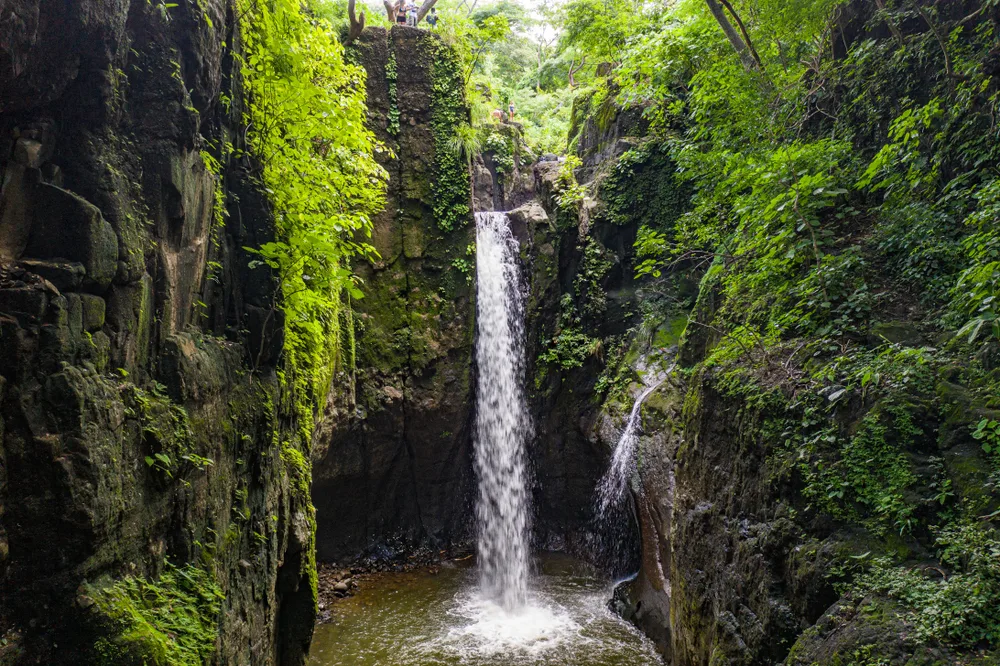
Hmedia/Shutterstock
Near El Tunco (about 10 miles away), the hike to Tamanique Waterfalls is a thrilling option if you love the idea of venturing deep in the jungle to reach thundering falls that flood into rivers and pools far from the modern world.
The Tamanique Waterfalls are within walking distance of the Tamanique town center (seriously, just steps away) and there are 6 gorgeous cascades you can check out on a single scenic hike. It’s mandatory to hire a guide to explore the trails that lead to the falls.
Begin on the waterfalls trailhead to amble downhill over cobblestone sections to the first falls (though called Waterfalls #3 and #4). You’ll pass though dense, leafy canopies and past the most rugged parts of the forest to reach the falls.
Water rages over the cliff sides, billowing over the rock to cascade into pools below that look emerald-green in their serene forest surroundings. To reach some of the falls, you’ll hang onto ropes and clamber over boulders, behind waterfalls, and up and down steep trails.
The falls here have swimming holes that are perfect for cooling down on a warm, sunny day. At Waterfalls #1 and #2, there’s a wooden platform you can jump from to launch yourself into the pool for a little adrenaline rush!
Getting your guide lined up is easy at the office in Tamanique (very small town) where the guild of guides operates. After a quick spiel about the falls and hiking conditions, you’ll register, pay your guide fees, and receive your guide assignment to do the hike.
10. Planes De Renderos
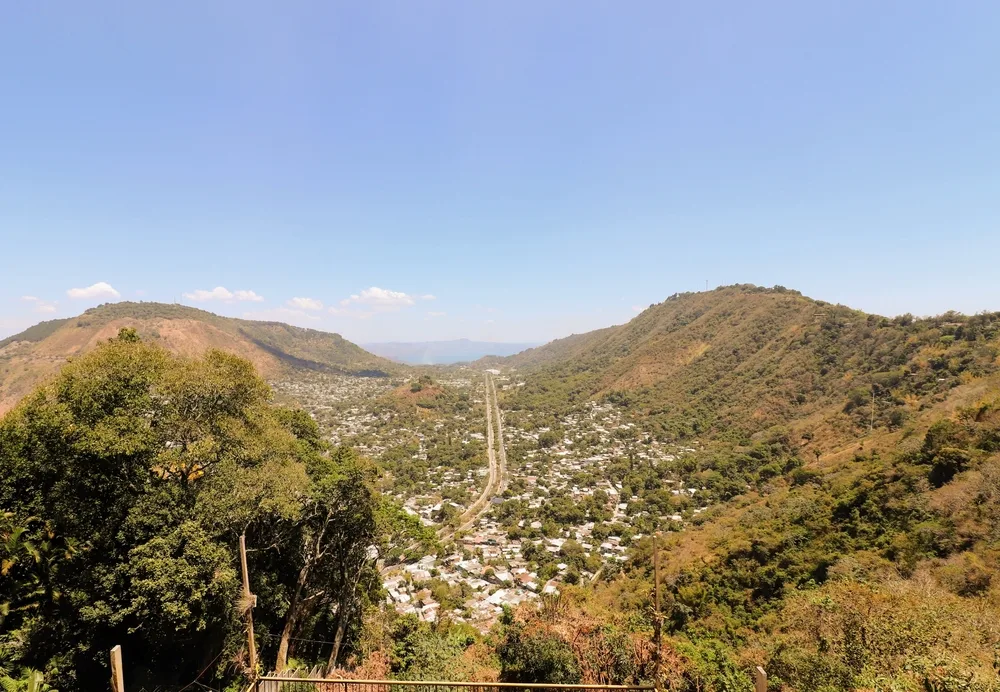
Vladimir Hidalgo/Shutterstock
Planes de Renderos (Renderos Plains) is a small town on the outskirts of San Salvador with a famous overlook, or mirador, point by the same name. If you’re in El Salvador, locals are sure to ask you if you’ve visited Planes de Renderos yet!
People come to this high-up lookout point year-round, day and night, to see great views of the nearby capital city of San Salvador, the volcano, and Lake Ilopango.
The scenic overlook point has become a go-to spot for great local food and shopping due to the markets, restaurants, and street food stalls that set up here. Pupusódromos are everywhere here, so you’ll be able to try local varieties like cheese, squash, bean, or shrimp pupusas piled high with fresh ingredients and spices.
If you’re lucky enough to arrive on a day with no fog, you’ll enjoy almost endless views over the volcanic mountain landscape below you and the cityscape of San Salvador — even more impressive when it’s all illuminated at night.
Handicraft and souvenir markets, great spots for photos, viewing points, hiking trails, and tables to enjoy your food are all here at this famed mirador in Planes de Renderos. It’s generally nice and cool at this elevation, even if you’re visiting during the hottest months (like March and April).
Not far away, the Devil’s Gate Lookout (Puerta del Diablo) offers similar views combined with a strenuous hike up a forested rock formation.
11. Cerro Verde National Park
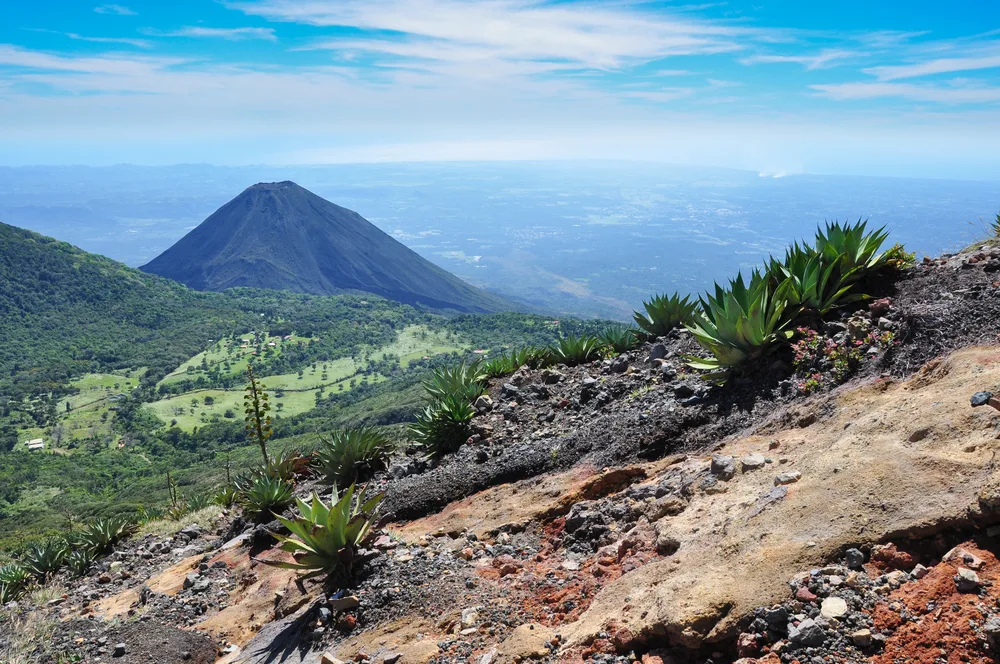
Huge Brizard-YouGoPhoto/Shutterstock
Translating to Green Hill National Park, El Salvador’s Cerro Verde National Park offers some of the most dramatic landscapes in the country with 3 volcanoes spanning the huge protected area with trails through pine and cloud forests, grassy plains, rushing rivers, and rolling hills.
Most people come to Cerro Verde to see the volcanoes. Izalco, Santa Ana, and Cerro Verde are all within the park and trails lead you to the craters and around the sloped sides of each one. At their summits, views of Lake Coatepeque and nearby towns are amazing.
The Santa Ana volcano stands 7,811 feet, the highest in the park. Cerro Verde, an extinct volcano, stands 6,660 feet above sea level. Izalco volcano is over 6,496 feet high! The park boasts excellent viewpoints and facilities that make it just right for all-day stay.
Some of the most popular trails in the park are the Old Mountain Hotel and A Window to Nature, leading through shaded forests and grasslands to destinations and overlooks throughout the park. You’ll need a guide to hike to the volcanoes.
There’s an orchid garden that plant enthusiasts will appreciate on the park’s Mysterious Flowers trail, surrounded by low, leafy ferns and covered by the green canopy overhead.
Animals thrive in this unspoiled park, and birding is particularly good here (nearly 130 species of birds live here). If you get here and decide you want to explore more the next day, book one of the cabins within the park — these have phenomenal views.
12. Chalchuapa Archaeological Site
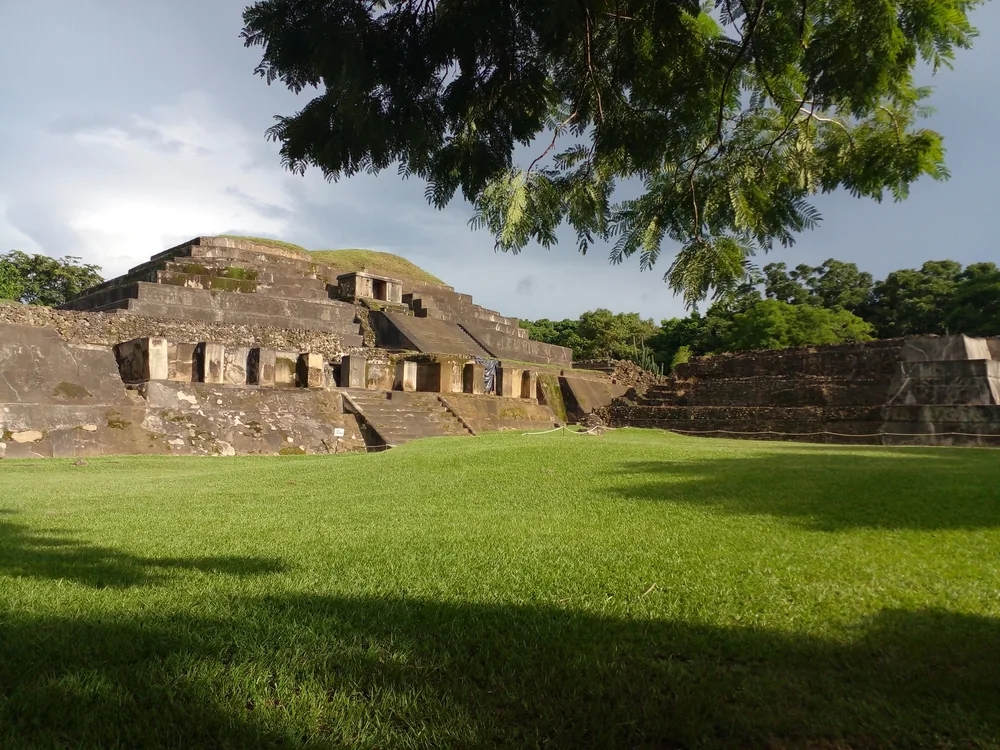
Anne Salazar/Shutterstock
Chalchuapa is a site with pre-Columbian Mayan ruins in El Salvador, just west of the historic city of Santa Ana in the dense forests that once were home to people of the Mayan civilization. Temples, pyramids, and dwellings ruins dot the site and make it truly fascinating to visit.
While Mexico gets most of the fame for Mayan ruins, the Tazumal Archeaological Park and Casa Blanca Archaeological Site ruins you’ll find at Chalchuapa are nicely preserved and only discovered by archaeologists around the start of the 20th century.
It was once a center of daily life and ceremony for the Highland Mayan people. There are 5 separate areas with ruins here in around 2.3 square miles: Tazumal, Trapiche (where the clear, fresh El Trapiche pool is), Pampe, Casa Blanca, and Las Victorias.
The Tazumal ruins are the most incredible, with a 75-foot tall pyramid and smaller, still-buried structures around it with twin pyramids flanking it to the west. Ladders, ceremonial grounds, and more structures can be seen to the north.
Deeply obscured by old-growth forest, the ruins here have since become a popular destination for tourists. Monuments, adobe and earthen mounds, and piles of broken pottery can still be seen around the ruins of Chalchuapa.
Artifacts recovered here have helped archaeologists understand the Mayan culture and daily life better, with finds like ceremonial incense burners, carved stelae (stone slabs with carvings), mounds, pottery vessels, and more.
13. Lake Ilopango
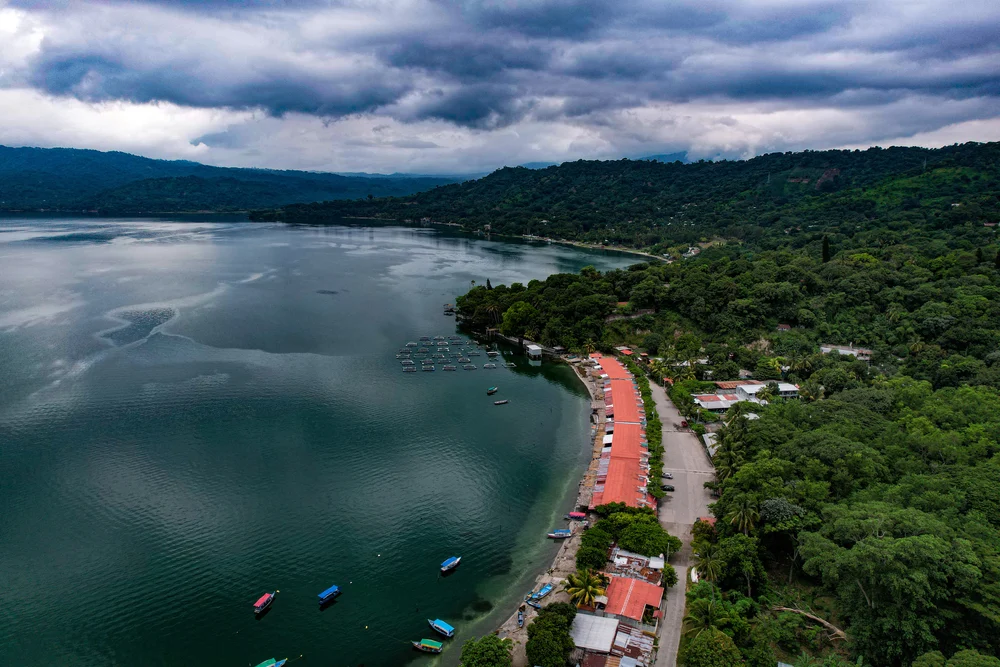
Saul Villatoro/Shutterstock
Lake Ilopango is a volcanic crater lake, filling up the San Salvador volcano caldera and making it one of the most beautiful — and the largest — lakes in all of El Salvador. It’s a popular place to swim, dive, and boat with its extensive underwater rock features and formations.
Rent jet skis to zip across the water’s surface, visit one of the waterfront huts to enjoy a picnic lunch, or book a boat tour around the lake and the small islands (Isla Quemadas) in its center to make the most of a day on Lake Ilopango.
Deep under the surface, the structure of the volcanic caldera can be seen in the 755′ deep, 18,000-acre lake. Hot water vents, underwater caves, steep ridges, volcanic rock formations — it’s all here and visible if you opt to go scuba diving in Lake Ilopango.
Isla Quemadas are home to nice little beaches and viewpoints in the center of this elevated, forested area on the waters of Lake Ilopango. Head out on a boat tour or rent a boat of your own to make your way to these secluded beaches and forests.
Fishing and boating are fun pastimes on the water. You’ll find ample tiger bass and small fish biting in the shallows. Boat and excursion operators are located around the shore.
Most people do their swimming around the shores of Apulo on the southwestern side of the lake, where public beaches provide amenities for an all-day hangout. Rent kayaks, jet skies, pontoon rafts, or speedboats to enjoy your lake day even more!
Situated just east of San Salvador, Lake Ilopango is a popular choice for a day trip from the capital city if you’re looking to get deeper into nature and explore more of El Salvador’s most rugged and beautiful wilderness.
14. Los Cobanos
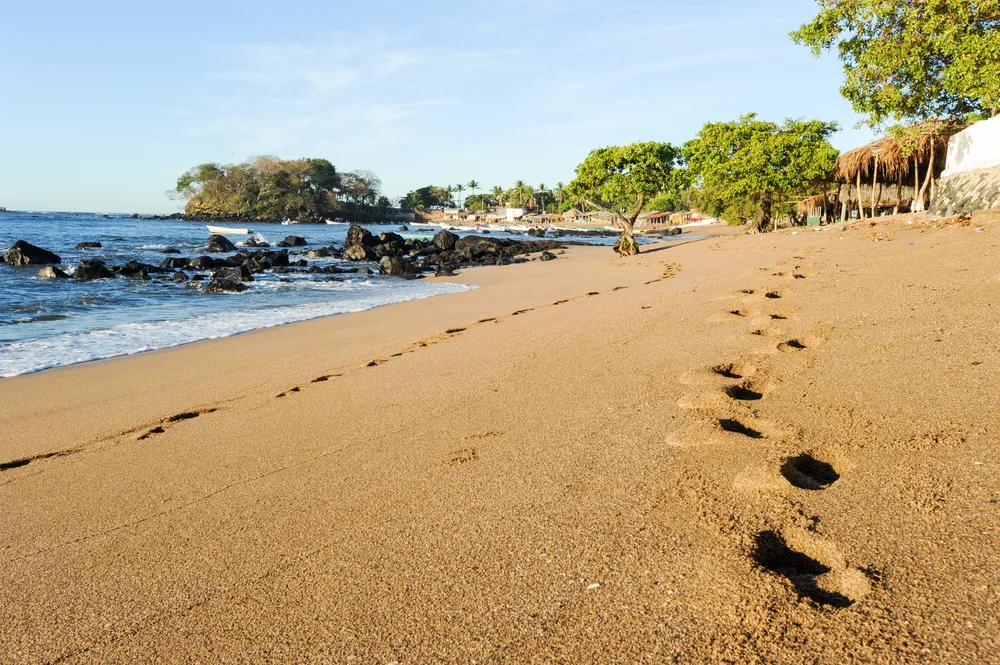
Stefano Ember/Shutterstock
Coarse, honey-colored sand, dark volcanic rocks dotting the shoreline, and the laid-back vibes that only a secluded ocean fishing village can bolster are all reasons Los Cobanos is one of the best places to visit in El Salvador.
Calm waters that sharply contrast with the major swells that draw surfers to the country’s rougher waters elsewhere. Here, Playa Los Cobanos and Playa El Flor are tranquil beach spots that are perfect for lounging in the sand, swimming, snorkeling, and enjoying life at a slower pace.
The quiet and serene atmosphere of the beach and its small town make it a relaxing place to visit, worlds away from the noise and buzz of San Salvador.
Marine life is abundant in the ocean with a surrounding Outer Reef that makes for excellent diving and snorkeling (especially between November and February, the dry season). People take to the waters around the reef to paddle board in the waters sheltered from the mighty Pacific’s waves and breaks.
Hire a guide to bring you to the Outer Reef and surrounding rock formations that are only visible on certain days due to the tides. Deep sea fishing charters can take you further out to reel in trophy catches like sailfish, tuna, and marlin when you’re ready for a little adventure after a few days of lazing on the shore.
15. San Andrés Archaeological Park
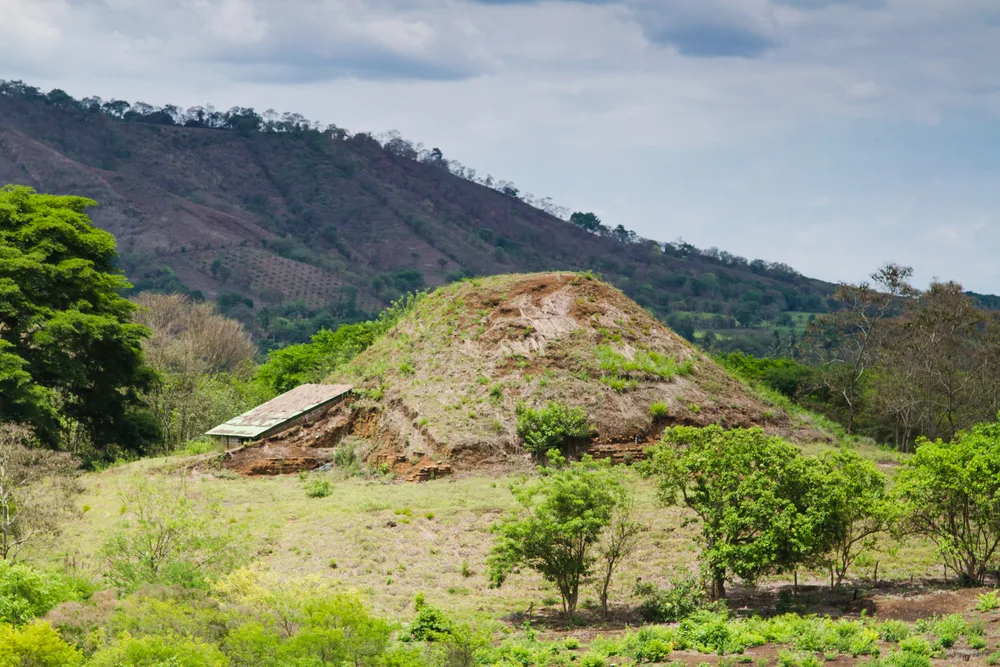
Milosz Maslanka/Shutterstock
If ancient ruins get you excited, El Salvador’s San Andrés Archaeological Park is one spot you’ve got to see on your trip. This site is one of the largest in the country, housing ruins of ceremonial, political, and residential structures like pyramids, homes, and a town “square.”
Between 600–900 AD, the Mayan people lived and thrived here near the La Libertad coast. Archaeologists have uncovered evidence that they were in touch with the Teotihuacan and Copan people, even trading with people in Belize and Guatemala.
This was the 200-hectare home and workplace for artists, priests, sellers, and leaders who ran the broader civilization in the valley.
Special places in the complex include the Acropolis, a raised main plaza where pyramids and adobe homes clustered together in the daily center of life in the ancient city, and pyramids on the northern side of the complex (one is a unique bell-shaped pyramid that hasn’t been seen in any other location).
There are 2 volcanic tuff block structures that stand apart from the mass of adobe blocks in the rest of the ancient site. Farmers’ huts show us that agricultural products, like corn and beans, were abundantly produced in the fertile soils of the valley.
A visit to the site today is one that’s still filled with mystery — compared to other Mayan sites, not much is known about this one and it’s definitely not as touristy as sites like Chichen Itza in Mexico. If you want to explore unspoiled ruins without big crowds, San Andrés is perfect.
Things to Consider
Visiting El Salvador is becoming more and more popular as people seek out the volcanic and beach landscapes this beautiful Central American country boasts. It’s always a good idea to arrive informed, so look through these travel tips and considerations before you go!
- Prioritize your safety. The U.S. State Department advises travelers to reconsider visiting El Salvador at this time due to increased crime around the country, including homicide and suspended constitutional rights as authorities crack down on crime and detain suspected criminals. Keep your safety a top priority and wait to travel or stick to tourist areas with solid police presence.
- Figure out how to get around. Part of the allure of El Salvador is making your way to the best places around the country, not staying put the entire time. Buses and taxis are the most common ways to get around. The Directo, called “chicken buses,” are cheap (think $0.25 or so) and plentiful around cities and towns. Especial buses, which are faster, cost slightly more. Shuttles may run between tourist areas if you need a quick connect to a nearby spot.
- Don’t worry about currency exchange. In El Salvador, the U.S. dollar and Bitcoin are the two accepted currencies. No need for currency exchange or mentally calculating exchange rates before you buy something! Bitcoin was named an official currency in 2021, while the dollar was made official currency back in 2001.
- Know when to visit. El Salvador experiences a balmy, pleasant dry season from November to April and a rainy season from May to October. The inland valleys tend to see the most rain during the wet season, while the coast and nationwide averages are slightly lower. If you have to travel between May and October, avoid inland valleys and stick to the coast and mountain regions.
Frequently Asked Questions
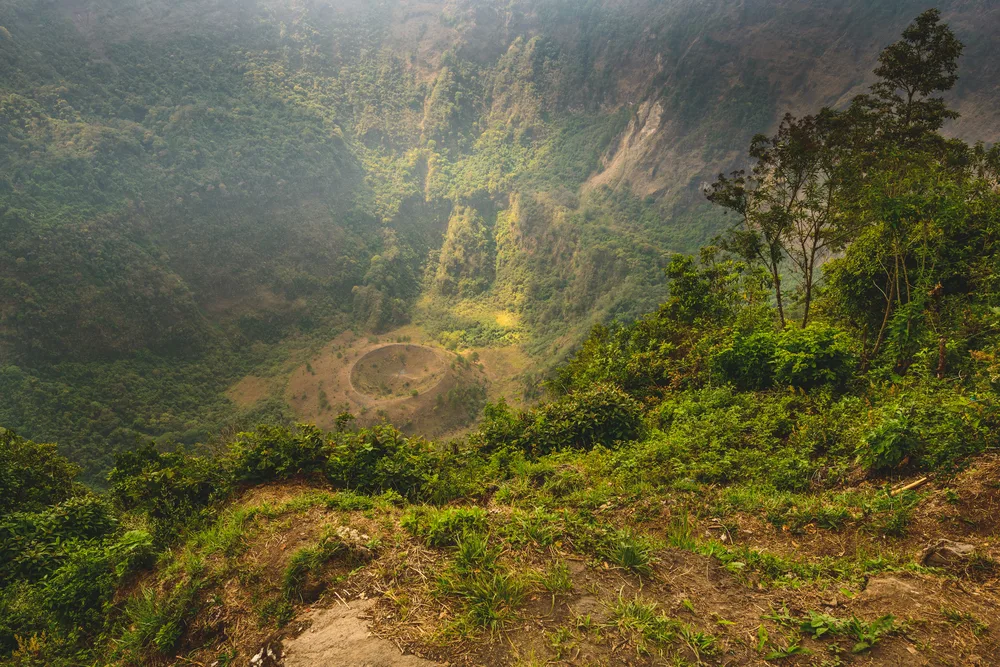
John Crux/Shutterstock
Stringing together some of the best places to visit in El Salvador to create the ultimate itinerary? Read through some of the most common traveler questions below to learn more and help plan your visit.
What is the best part of San Salvador?
The historical center of San Salvador, Centro HIstorico de San Salvador, is the best part of the city with cobblestone streets, the famous National Palace museum, Iglesia El Rosario church, the National Theater, and the Art Museum of El Salvador filled with works from Salvadoran artists.
Is El Salvador good for tourists?
El Salvador can be good for tourists who stick to tourist-centric areas and stay out of rough districts far from sightseeing destinations. El Salvador does experience higher crime rates and the U.S. State Department warns travelers to reconsider visiting the country while crime rates are elevated.
Where do people vacation in El Salvador?
People usually vacation around the El Salvador coastline, either on the Pacific Ocean (like Los Cobanos or El Tunco) or on the Gulf of Fonseca (like Playa Las Tunas or Playa El Chiquirin). Adventure trips are typically to the volcanoes and trails in Cerro Verde National Park or to La Rutes de Las Flores towns for waterfalls, charming villages, and outdoor recreation.
What is El Salvador most famous for?
El Salvador is most famous for its small size, being the smallest Central American country, and for its many volcanoes, which have earned it the nickname the “Land of Many Volcanoes.” There are around 20 volcanoes, including some extinct, dormant, and active, in this tiny country. You’ll find unique landscapes like volcanic crater lakes to explore as well.
Why is El Salvador crime so high?
Crime in El Salvador was historically elevated with higher gang activity, but government crackdowns have reduced violent crime nationwide, but higher homicide rates in some areas and a lack of resources to respond to crime have left some parts of the country less safe to visit than others.
So, Where Should You Visit in El Salvador?
From Spanish Colonial architecture and beauty in colorful Suchitoto to the nonstop bustle and delicious aromas of the historic capital, San Salvadore, El Salvador is packed with interesting destinations that will broaden your travel horizons and expose you to a totally new way of life.
From hiking to volcanic craters and thundering waterfalls in the forest to oceanside escapes in backpacker-frequented beach towns, this country has something for every type of traveler during short or longer stays.
While we can give you an idea of where you should visit in El Salvador, it’s up to you to decide which spots are a good fit for your trip. It’s hard to go wrong with so many incredible sights and activities in this Central American gem!



